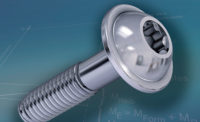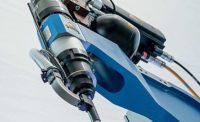Magnesium is an attractive material for auto parts. It's 36 percent lighter than aluminum and 78 percent lighter than steel, yet it has a better strength-to-weight ratio than either metal. It's also highly moldable. Magnesium parts can be die-cast with walls as thin as 0.8 millimeter and draft angles of less than 0.5 degree. A large magnesium casting can often replace a steel fabrication comprised of many parts.
Automotive assemblers use magnesium alloys to make a host of parts for the interior, chassis and power train, including transmission housings, transfer cases, intake manifolds, support brackets, steering wheels, and instrument panel frames. Since 1990, the use of magnesium alloys in automotive applications has increased 20 percent annually, and a typical vehicle now contains 8 pounds of the metal.
Automotive assemblers aren't the only manufacturers who are taking advantage of magnesium's unique properties. The metal is increasingly being used in consumer electronics, power tools, lawn and garden equipment, sporting goods, aircraft and weapons systems. In fact, the use of magnesium alloys in manufacturing is expected to double over the next decade.
"Magnesium is no longer an exotic material," says fastening consultant Thomas S. Doppke of Sterling Heights, MI.
Unfortunately, while engineers have decades of experience fastening steel parts, there is much less knowledge about assembling magnesium parts. Threaded fasteners that work in steel or aluminum parts may be inappropriate for magnesium parts. The same can be said of screwdrivers. Torque, angle and speed settings that were appropriate for installing screws in steel parts may not work with magnesium parts.
Magnesium is not as ductile as steel, and that can cause problems when using threaded fasteners to assemble parts made of the metal. "Magnesium is brittle. It's like fastening glass," explains Doppke, a former engineer with General Motors Corp. "You can't use thread-cutting screws, because the threads break off. You can't use pierce nuts, because you can't bend the metal into the grooves. It doesn't work. The magnesium cracks."
"People think magnesium acts like die-cast aluminum or zinc, because [magnesium alloys] include those elements," adds Bob Schneider, program coordinator at Textron Fastening Systems (Troy, MI). "But, magnesium is more friable. So when you're trying to create a thread, you create debris."
Thread-forming screws for steel parts feature closely spaced threads that have a 60-degree flank angle. Schneider says such fasteners are too aggressive for magnesium parts. The metal will gall and seize in the threads. "If you put the screw in and out a few times, you'll end up reaming the threads out," he warns.
A related problem is that a steel screw is much stronger than magnesium. Under clamp load, magnesium can slowly flow away from the fastener, causing the joint to loosen over time. "You can only tighten the joint to the strength of its weakest member," advises Doppke.
As a result, engineers should design magnesium parts to provide more thread engagement than comparable steel parts. As a rule of thumb, the length of thread engagement in a steel part typically needs to be only 0.75 to 0.87 times the diameter of the fastener. In contrast, the length of thread engagement in a magnesium part should be 1.5 to 2 times the diameter of the fastener. If the hole can't be made deeper, it can be made smaller in diameter, so that a greater portion of each thread is engaged.
Galvanic corrosion is another concern when fastening magnesium parts. When magnesium contacts other metals in the presence of an electrolyte, such as road salt, severe galvanic corrosion can occur. To keep that from happening, the mating parts must be made of galvanically compatible metals; plated with galvanically compatible metals, such as zinc; or coated with an electrically insulating material, such as nylon. Ferrous alloys, titanium alloys, and nonferrous alloys containing nickel or copper have poor galvanic compatibility with magnesium.
Aluminum screws are available for fastening magnesium parts. However, aluminum screws may not be strong enough to form threads in some magnesium alloys.
In addition, engineers can design the joint to limit exposure to electrolytes. For example, screws should be driven into blind holes instead of through holes, so the tip of the fastener is not exposed to the environment. Clearance should be provided around the fastener head to permit drainage. The fastener can also be paired with a washer made of aluminum or a nonconductive material.
Fastener Options
Assemblers can drill and tap holes in magnesium castings. However, the porosity of castings can be an issue during drilling, and special lubricants are usually needed to prevent galling.If high-strength threads are needed, threaded inserts can be pressed or shrunk into magnesium, but screwed-in inserts are preferred. One type of screwed-in insert is tubular, with threads cut into both the interior and exterior surfaces. Another type of screwed-in insert is a helical coil of spring wire. At rest, the coil is larger in diameter than the tapped hole. During assembly, the torque applied to the tang reduces the diameter of the leading coil, enabling it to enter the tapped thread. When the rotation is stopped, the coils expand with a spring-like action, anchoring the insert in place.
Alternatively, blind-installed threaded rivets, such as the Rivnut from Bollhoff Rivnut Inc. (Kendallville, IN), can be used. Rivnuts are internally threaded tubular rivets with thin-walled shanks. During installation, the bottom of the fastener is pulled upward, compressing the shank and forming a large flange behind the hole that holds the rivet securely in place.
Thread-forming screws are perhaps the most efficient means of fastening magnesium parts. These screws eliminate the cost of drilling, tapping, cleaning and inspecting holes, and they give designers more flexibility than nut-and-bolt assemblies.
Several thread-forming screws have been designed specifically for magnesium parts. One example is the Mag-Form screw from Textron Fastening Systems. It has a multilobular profile, widely spaced threads, and a broad, 105-degree flank angle. When driven into magnesium, a compressive action forms strong threads with minimal debris generation. The large flank angle allows the fastener to be inserted and removed multiple times without damaging the threads.
"With the Mag-Form, you're really burnishing the material," says Schneider. "You're pushing it out of the way, rather than trying to get it to flow."
The ALtracs thread-forming screw from ATF Inc. (Lincolnwood, IL) balances the strength differences between steel and magnesium. The strength of the steel is offset by decreasing the cross-sectional area of the threads. The threads have a 33-degree asymmetrical flank angle, which minimizes the amount of material they displace. The flank root support gives stability to the thread in high clamp load conditions without hindering material flow during thread forming.
The thread-forming zone consists of a tapered, noncircular point with thread-forming relief flats. The taper helps assemblers align the screw in the hole and decreases the amount of force and torque needed to start the thread-forming process. The flat areas in the thread provide relief during thread-forming, which reduces drive torque.
"In a lot of applications where magnesium is used, vibration and temperature variation are a problem," says Jason Surber, an ATF engineer. "Because magnesium and steel relax at different rates, the fastener can back out. That's where the 33-degree asymmetrical thread profile comes into play. It has better clamp load performance than even a machine screw."
In fact, the threads produced by the ALtracs fastener are compatible with standard metric machine screws. So, if the original fastener is lost during service, it can be replaced with a machine screw of the same diameter, says Surber.
Another thread-forming screw for magnesium is the Remform F screw from Research Engineering and Manufacturing Inc. (Middletown, RI). A variant of the Remform screw for assembling plastics, the Remform F has the same asymmetrical thread form as the original fastener, but a finer thread pitch. The asymmetrical thread creates opposing forces during thread forming, which improves material flow. The radiused form of the leading thread flank efficiently displaces material, minimizes radial forces during thread forming, and decreases thread-forming torque. The steep trailing, or pressure, flank opposes the fastener head and resists stripping and pull-out. The thread's narrow tip angle minimizes disturbance of the magnesium.
Tool Time
The mechanical properties of magnesium affect not just the choice of fastener, but how the fastener is installed.For example, to prevent galling and seizing, driver speed should be kept below 1,000 rpm, advises Schneider. If galling occurs, the peak torque can be reached before the joint reaches full clamp load.
Prevailing torque is another issue. When driving screws into magnesium, the thread-forming torque can exceed the seating torque, causing the tool to shut off prematurely. A computer-controlled DC electric tool can detect and overcome this problem, says Ian Chapman, fastening integration manager at Ingersoll-Rand (Annandale, NJ).
"We have developed an algorithm that measures and ignores prevailing torque during the run-down," he says. "When the fastener gets past the ‘clicking zone,' the tool starts applying the correct seating torque."
For additional quality control, engineers can set limits on how much prevailing torque the tool will ignore. So if, for example, a cast hole is too small, the tool will detect a very high prevailing torque and alert the operator to the problem. Similarly, the tool can issue an alarm if it detects a sawtooth torque curve, an indication of galling, says Chapman.
A programmable tool can also overcome problems associated with the difference in strength between the screw and the magnesium alloy. "If you're driving into a tapped hole...the screw is likely to start cutting its own thread," says Boris Baumler, applications engineer at Deprag Inc. (Lewisville, TX). "An electric tool can be programmed to start driving the screw at a low torque. If the screw starts cutting a thread, the tool will stop, before it can damage the hole."
Regardless of what fastener or tool is used to assemble magnesium parts, engineers are well-advised to test a number of fasteners and fastening tools in their applications. "You can't just drive the screws and forget about them," says Chapman. "Quite of bit of application testing is required...particularly when fastening materials you're not used to seeing."





